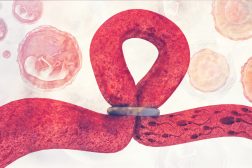Definition
noun, plural: placentae or placentas
(1) (zoology) The vascular organ formed during gestation of female mammals (except for monotremes and marsupials), and that which is used to channel food and oxygen nourishment from the mother to the fetus, as well as to eliminate fetal waste products
(2) (botany) The part of the ovary where ovules develop in flowering plants and the spores in non-flowering plants
adjective
placental
(1) Of, pertaining to, characterized by, having a placenta
(2) Pertaining to a placental mammal; belonging to the taxonomic subdivision Placentalia
Supplement
In zoology, placenta pertains to the organ characteristic of true mammals during pregnancy, joining mother and offspring, providing endocrine secretion and selective exchange of soluble, but not particulate, blood borne substances through an apposition of uterine and trophoblastic vascularised parts. According to species, the area of vascular apposition may be diffuse, cotyledonary, zonary or discoid, the nature of apposition may be labyrinthine or villous, the intimacy of apposition may vary according to what layers are lost of those originally interposed between maternal and foetal blood (maternal endothelium, uterine connective tissue, uterine epithelium, chorion, extraembryonic mesoderm and endothelium of villous capillary). The chorion may be joined by and receive blood vessels from either the yolk sac or the allantois and the uterine lining may be largely shed with the chorion at birth (deciduate) or may separate from the chorion and remain (nondeciduate). The human placenta is discoid, villous, haemochorial, chorioallantoic and deciduate. After birth, it weighs about 600 gm. And is about 16 cm. In diameter and 2 cm. Thick, discounting a principal functional part, the maternal blood in the intervillous space (which leaks out at birth) into which the chorionic villi dip. The villi are grouped into adjoining cotyledons making about 20 velvety bumps on the side of the placenta facing outward to the uterus, the inner side of the placenta facing the foetus is smooth, being covered with amnion, a thin avascular layer that continues past the edges of the placenta to line the entire hollow sphere of chorion except where it is reflected to cover the umbilical cord, which joins foetus and placenta. The cord usually joins the placenta near the centre but may insert at the edge, on the nonplacental chorion or on an accessory placenta. That part of the ovary of a flowering plant where the ovules form. The vascular structure in the uterus of most mammals providing oxygen and nutrients for and transferring wastes from the developing fetus. The structure that forms on the uterine wall that allows nourishment of the embryo via the mothers blood supply.
In botany, the placenta refers to the part of the ovary where ovules develop in flowering plants. In non-flowering plants, the placenta pertains to that part where spores develop.
Word origin: Latin placenta (“flat cake”)
Synonym:
- afterbirth (zoology)
See also:
Related term(s):
- abnormal placental size
- accessory placenta
- adherent placenta
- battledore placenta
- horseshoe placenta
- monochorionic monoamniotic placenta
- placenta accessory
- placenta accreta
- placenta accreta vera
- placenta biloba
- placenta percreta
- placental growth factor
- placental lactogen
- placental mammal
- Placentalia
- retained placenta
- succenturiate placenta
- supernumerary placenta
- twin placenta
- villous placenta





